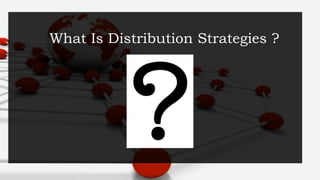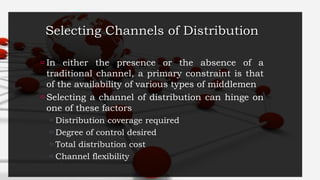Distribution strategy
- 1. GROUP NO: 7
- 2. D I S T R I B U T I O N STRATEGY
- 3. “Marketing channels are sets of interdependent organizations involved in the process of making a product or service available for use or consumption” Philip Kotler
- 4. What Is Distribution Strategies ?
- 5. The Importance of Channels oMarketing channels also represent a substantial opportunity cost oOne of their chief roles is to convert potential buyers into profitable customer, oMarketing channels must not just serve markets, they must also make markets
- 6. Marketing Channel Strategy Producer Intermediaries Consumer inducing Producer Intermediaries Consumer ordering Push Strategy Pull Strategy When intermediaries can be persuaded to stock the product, in preference to those of competitors, then when customers visit a sales outlet and ask for a product by its generic name it is the product of the company which is supplied. Creating such a strong preference for the product among end users that the resulting demand pulls the product through the channel of distribution.
- 7. HYBRID CHANNEL & MULTICHANNEL MARKETING Multichannel Marketing “marketing using many different marketing channels to reach a customer” Rangaswamy, Arvind; Gerrit H. Van Bruggen (2005). Opportunities and challenges in multichannel marketing PRODUCER INTERMEDIARIES CONSUMER
- 8. HYBRID CHANNEL & MULTICHANNEL MARKETING Channel Integration “the merging of retail operations in such a manner that enables the transacting of a customer via many connected channels” https://www.boundless.com/marketing/marketing-channels/marketing-channel- relationships/channel-integration/ ONLINE ORDER OUTLET DELIVERY
- 9. THE ROLE OF MARKETING CHANNEL Channel Function • Forward flow functions: • From company to customers • Develop / disseminate communication • Store and move the physical products • Oversee transfer of ownership • Backward flow functions: • From customers to company • Place orders with manufacturers • Facilitate payment of bills • Forward and backward flow functions: • Gather information • Negotiate price and transfer of ownership • Finance inventories • Assume risk
- 10. THE ROLE OF MARKETING CHANNEL Channel Levels • Zero level channel • One level channel • Two level channel • Three level channel
- 11. THE ROLE OF MARKETING CHANNEL Service Sector Channel Service sector channels use agencies and locations to access population to be served • Banking • Insurance • Travel “Kodak offers its customers four ways to print their digital photos-minilabs in retail outlets, home printers, online services at its Ofoto Website, and self- services kiosks. The world leader with 80.000 kiosks, Kodak makes money both by selling the units and by supplying the chemical and paper they use to make the prints.”
- 12. CONFLICT, COOPERATION & COMPETITION • Type of conflicts: • Vertical Conflict “Conflicts between different levels within the same channel” • Horizontal Conflict “Conflicts between same levels within the different channel” • Multi-Channel Conflict “Conflicts when multiple channels are employed and all sell to same market
- 13. Goal Incompatibility Unclear Roles & Rights Differences In Perceptions Intermediaries’ Dependence On The Manufacturer Cause of Conflict
- 14. Type of Marketing Channels • Most channel options involve at least one marketing intermediary, an organization that operates between producers and consumers or business users. • A retailer owned and operated by someone other than the manufacturer of the products it sells. • A wholesaler who takes title to the goods it handles and then distributes these goods to retailers, other distributors, or sometimes end consumers. • Service firms market primarily through short channels because they sell intangible products and need to maintain personal relationships within their channels.
- 15. DIRECT SELLING • Direct channel—carries goods directly from a producer to the business purchaser or ultimate user. • Direct selling—a marketing strategy in which a producer establishes direct sales contact with its product’s final users. • Internet and direct mail are also potentially important tools for direct selling. CHANNELS USING MARKETING INTERMEDIARIES • For some products, using intermediaries may be more efficient, less expensive, and less time-consuming.
- 16. DUAL DISTRIBUTION • Movement of products through more than one channel to reach the firm’s target market. • Used to maximize the firm’s coverage in the marketplace or to increase the cost-effectiveness of the firm’s marketing effort. REVERSE CHANNELS • Channels designed to return goods to their producers. • Growing importance because of rising prices for raw materials, increasing availability of recycling facilities, and passage of additional antipollution and conservation laws. • Also used for recalls and repairs.
- 17. Selecting Channels of Distribution In either the presence or the absence of a traditional channel, a primary constraint is that of the availability of various types of middlemen Selecting a channel of distribution can hinge on one of these factors Distribution coverage required Degree of control desired Total distribution cost Channel flexibility
- 18. Selecting Channels of Distribution Distribution coverage – Channel selection may depend upon the nature of market coverage desired Intensive distribution – Using as many wholesalers and retailers as possible Selective distribution – Using only the best available per geographic area Exclusive distribution – Selected intermediaries are given exclusive rights within a particular territory
- 19. Selecting Channels of Distribution Degree of control desired – Achieved by the seller is proportionate to the directness of channel Total distribution cost – Channel should be viewed as a total system composed of interdependent subsystems Objective should be to optimize total system performance Generally assumed that the total system should be designed to minimize costs, other things being equal Channel flexibility – Ability of the manufacturer to adapt to changing conditions
- 20. Exclusive Distribution ◦ Limiting the distribution to only one intermediary in the territory Intensive distribution ◦ Distribute from as many outlets as possible to provide location convenience Selective distribution ◦ Appoint several but not all retailers Distribution Strategies
- 21. Basic Channels of Distribution Manufacturers/products Agents/brokers Wholesalers/distributors RetailersRetailers Consumers and organizational end users
- 22. Using two or more different channels to distribute goods and services Why? ◦ Permits optimal access to each market segment ◦ Increase market coverage, lower channel cost and provide more customized selling What to look out for? ◦ More channels usually means more conflict and control problems Multiple-Channel Strategy
- 23. Each channel handles a product or segment that is different or non- competing e.g. • Toyota Lexus • MPH online portals • Magazine distributions Complementary Channels
- 24. The same product is sold through two different and competing channels e.g. ◦ Non-prescriptive drugs ◦ Electronic goods Why? To increase sales What to look out for? ◦ Over extending yourself ◦ Dealers’ resentment ◦ Control problems Competitive Channels
- 25. Modify when the following changes occur: Consumer markets and buying habits Customer needs Competitor’s perspectives Relative importance of outlet types Manufacturer’s financial strength Sales volume level of existing products, and The marketing mix Modifying Distribution Strategies
- 26. One of the importance of any website or business is to bring the products or services to the right people and to reach the target audience. There are a number of different distribution channels available on the Internet which could be utilised efficiently to the benefits of any company E-Commerce: Online Distribution
- 27. The Types of Warehouse Storage warehouses: hold goods for moderate to long periods of time to balance supply and demand Distribution warehouse: assemble and redistribute goods as quickly as possible
- 28. Tasks in Physical Distribution Management - Physical distribution refers to the actual physical flow of products - In contrast, physical distribution management is the development and operation of processes resulting in the effective and efficient physical flow of products - Effective physical distribution management requires careful attention to five interrelated activities: 1. Order processing 2. Inventory control 3. Inventory location and warehousing 4. Materials handling 5. Transportation
- 29. Tasks in Physical Distribution Management 1. Order Processing - The starting point in a physical distribution system is order processing, which is a set of procedures for receiving, handling, and filling orders promptly and accurately - Electronic data interchange (EDI): - Between customer and supplier orders, invoices, and other business functions are transmitted by computer - Originally, EDI required a direct computer link between supplier and customer, now it is being conducted via the Internet - EDI can trim the cost of order processing significantly, which in turn may reduce purchase prices
- 30. Tasks in Physical Distribution Management 2. Inventory Control - The goal of inventory control is to satisfy the order- fulfillment expectations of customers while minimizing both the investment and fluctuations in inventories - Just-in-Time: - JIT combines inventory control, purchasing, and production scheduling - Applying JIT, a firm buys in small quantities that arrive just in time for production and then it produces in quantities just in time for sale
- 31. Tasks in Physical Distribution Management 2. Inventory Control (continued) - Just-in-Time: Benefits of JIT are: - Dramatic cost savings - Shortened and more flexible and reliable production and delivery schedules - Quick responses to quality problems - Market-Response Systems: - The central promise is that those who intend to consume a product should activate a process to produce and deliver replacement items - In this way, a product is pulled through a channel on the basis of demand
- 32. Tasks in Physical Distribution Management 3. Inventory Location and Warehousing - Management must make critical decisions about the size, location, and transportation of inventories - These areas are interrelated, often in complex ways - One key consideration in managing inventories is warehousing, which embraces a range of functions, such as assembling, dividing, and storing products and preparing them for reshipping
- 33. Tasks in Physical Distribution Management 4. Materials Handling - Selecting the proper equipment to physically handle products, including the warehouse building itself, is the materials handling subsystem of physical distribution management - Equipment that is well matched to the task can minimize losses from breakage, spoilage, and theft - Efficient equipment can reduce handling costs as well as time required for handling
- 34. Tasks in Physical Distribution Management 5. Transportation - Management must decide on both the mode of transportation and the particular carriers - The leading modes of transportation are railroads, trucks, pipelines, water vessels, and airplanes - Using two or more modes of transportation to move freight is termed intermodal transportation; this approach is intended to seize the advantages of multiple forms of transportation
- 35. CONCLUSION - Most producers use channels to market their product. - Effective management should include selection, training and motivating g channel members. - All channels have potential to conflict and should be managed well. - Channel selection should consider legal issues. - E-commerce and other ICT areas are still growing and can be explored for marketing. - It should be considered to use retail, wholesaling or both channel. - Marketing logistic is on importance decision related to marketing channels.
- 37. Thank you GROUP 7 Members : Midhun chandran Melin johnson Richa pandey Rohini kumara Rishi Joseph selvin




































